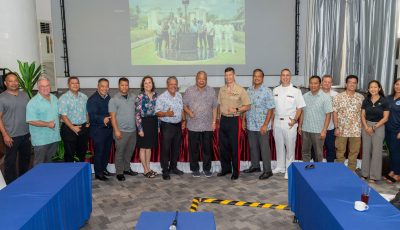In search of home at home
The birth of several indigenous groups in Guam converging to re-chart reclaiming their destiny as permanent hosts of the island is heartwarming. Their sentiment reflects the deep longing to come home to the very essence of traditional “island way of life.”
You have to be Chamorro to understand “home” through an indigenous lens or prism. Otherwise, you’d be struggling to come to terms with it.
Indeed, the emerging debate has wedged the imperialist tradition vs. resistance. The former prefers statehood the latter independence.
The divide borders on a revolution of sort for pro-independence. It is about the self, indigenous hearts, and spirits as permanent hosts of home. Is exterior progress an indelible part in the livelihood of Chamorros or is it a glorification of exogenous investment focused on their quest for profit at the expense of the local people? Is the prostitution of local culture progress in itself? When could this promotional fallacy be rectified so it is reflective of traditional culture?
Growth from without brings home a highly relevant query, e.g., Development for Who? What’s the investment share of the indigenous people in the tourism industry? Are they only good for menial jobs? Doesn’t this mindset turn them into simple cogs supporting an industry that exploits what they are not? How much in tourism profits actually stay behind and earmarked for the wellbeing of the indigenous people? Shouldn’t this investment and expansion best had by making the indigenous people permanent partners? Has this happened and would it ever materialize?
I only saw a brief part of the film, Guam: American Soil—Chamorro Soul. The relevant queries raised sufficiently express the longing to find home once more. It isn’t physical displacement they wish to recapture as much as island family values tethered to culture and tradition. It’s the simple village life with a strong sense of an island community.
It’s the massive development that has changed a Way of Life from one of humble village settings to a metropolis. It’s dizzying and disorienting and so they buckle down to regrouping and hopefully re-chart for meaningful planning and mapping of destiny.
The huge growth of what an island indigenous writer/advocate called “militourism”—military and tourism expansion—moving in tandem and its displacing effects had islanders asking if this is their future. How much of it should the indigenous people take? Is permanent displacement the prize of progress—for others, its success only defined and seen through the prism of the military and investors? What about the fate and future of the permanent host?
We’ve come a long ways as part of the greater American community. In the process, we’ve also learned that imperialism may be hard to overcome but it isn’t the final answer either. The future of the indigenous people must come from within employing its prism especially on substantive issues such as their future.
Caveat: Before Guam begins negotiations to resolve its political destiny the indigenous people must insist upon an official apology from both Spain and the U.S. The sale of the island and her people in 1898 is the most egregious and atrocious crime in recent history!
Did you forget that Chamorros are people too? Why the persistent delay by the feds to pay war reparation? Fear of establishing “precedent?” Didn’t Uncle Sam resolve the Micronesian War Claims? Isn’t this a glaring precedent?
Of “we the people”: Villagers came out in opposing a major project around the Pago Bay area in southern Guahan. In no uncertain terms, the simple folks say “No Señor” to a project that would gradually destroy a way of life around the bay. In other words, villagers are satisfied with what they are blessed with strong sense of community.
Human and traffic congestion would have changed normal village conduct beyond the current tranquil setting. How do you explain to the satisfaction of villagers an impending disruption against their way of life? I doubt they’d be willing to sacrifice a lifestyle superficially giftwrapped in the term “progress”.
The opposing sentiment is a tale that the triad: planners, developers and investors must begin descending into listening to the “will of the people” in the affected village. What’s in it for them beyond a monstrosity that robs them of a humble village life? Is it hard for the triad to see the project from the “prism” of villagers? For once in your lifetime you must learn to listen to the “will of the people.” The idea of turning villagers into “cogs” in the project is either riddled with arrogance or ignorance or both!
Moreover, what’s in it (project) for villagers? Are they permanent partners (permanent part of the investment) or just cheerleaders as investors repatriate millions of dollars from the use of indigenous land? This is an issue that must never escape the nimble minds of investors and it’s just as good a time indigenous landowners to begin dissecting forthwith.
Humility: Investors have come and taken over prime land for their hotels and resorts. Most of the best spots are gone! It included the desecration of ancestral burial site or traditional landing ground of fishermen of yester-years.
This experience reminds me of the song “Waimanalo Blues” (Nanakuli) by Polynesian Brother Henry Kapono. His sentiment alludes to prime beaches sold for hotels “my father and I once knew”. The loss of familiar beaches could only be memorialized in an islander’s blues with sentimental expression of what was once theirs.
The bold economic ventures may have generated millions, if not, billions at the expense of the degenerative effects it has had on the livelihood of our Polynesian brothers and sisters. I still can’t perceive displacement right at home forced upon the combined efforts of U.S. businessmen and the military.
Was it hard settling down to seeking lasting partnership? Do you now understand why the need to probe investment in its current form? How much longer do you wish to sink simply accepting dictates from without?



























